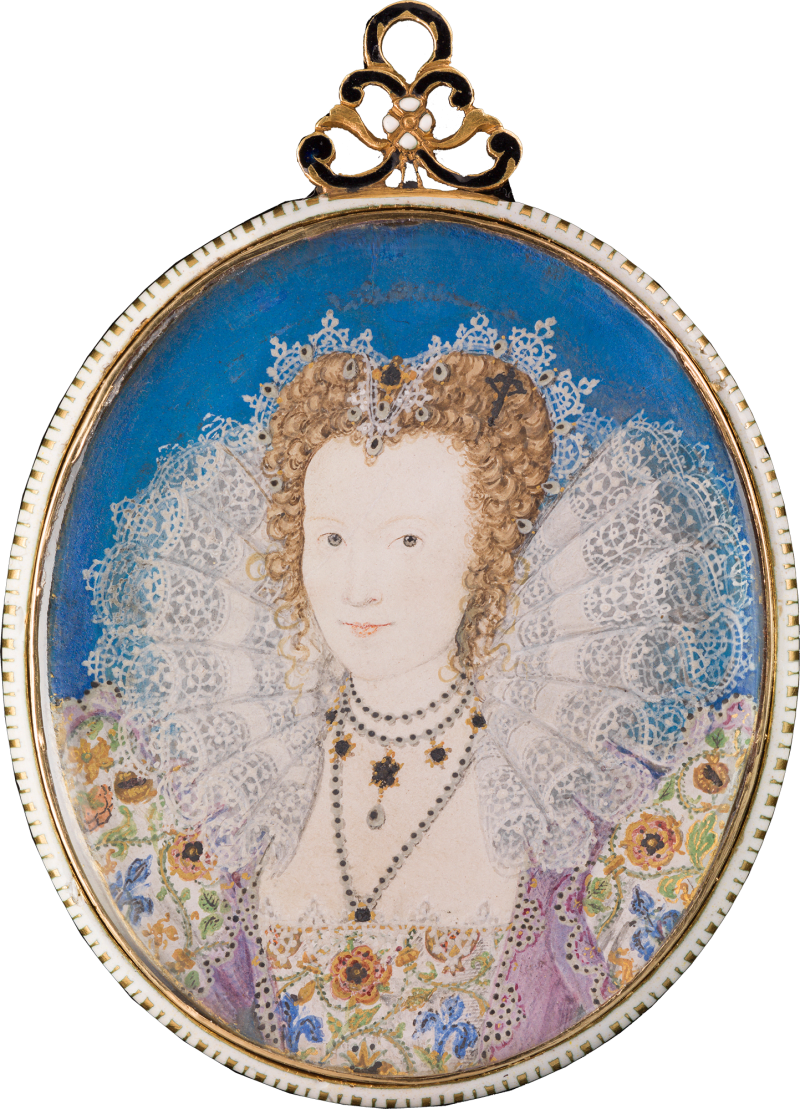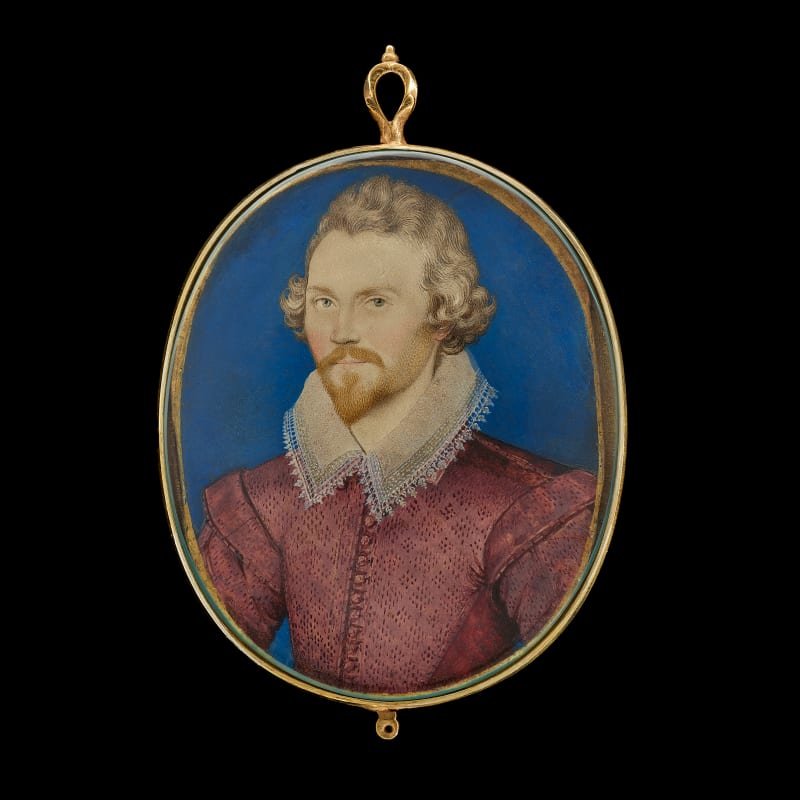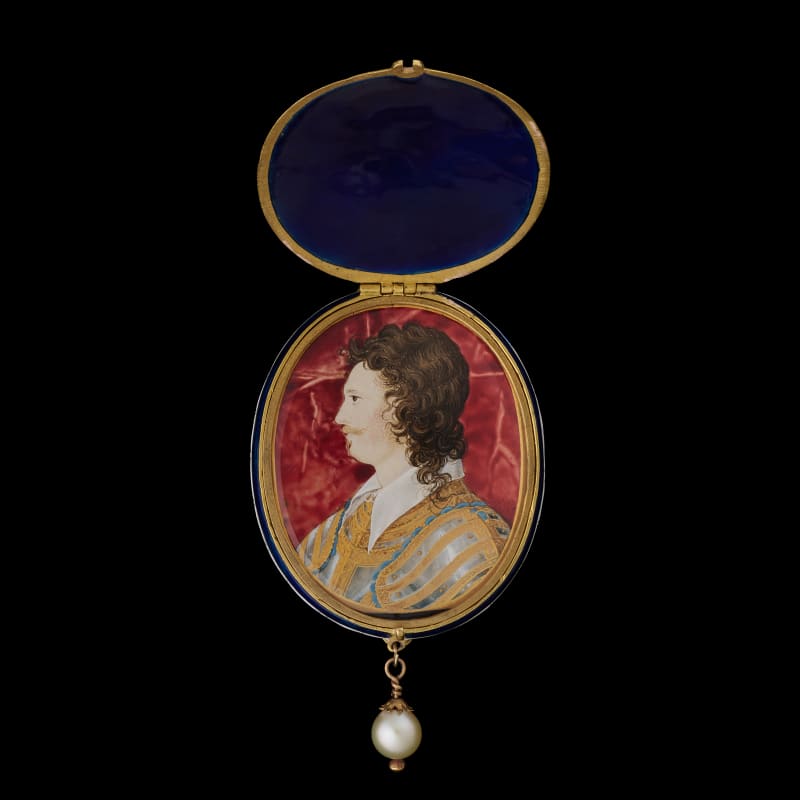Going at least as far back as the eighteenth century, when Sir Horace Walpole owned this miniature, it has been identified as a portrait of Lady Elizabeth Stanley (1587–1633), third and youngest daughter of Ferdinando Stanley, 5th Earl of Derby, and his wife, Alice, née Spencer. Via her father, Elizabeth was – like her elder sisters, Anne and Frances – a direct descendant of Henry VII and, thus, in her youth a potential successor to the ageing and childless Queen. On 15 January 1601, Elizabeth married Henry Hastings, who became 5th Earl of Huntingdon on the death of his grandfather in 1604.[4] No certain image of the young Elizabeth is known to survive for purposes of comparison with this miniature. But an engraved portrait of the mature Elizabeth by John Payne printed in 1635 (two years after her death) as the frontispiece to ‘A Sermon Preached at Ashby-de-la-Zouche’ depicts a woman with a similarly prominent nose, broad forehead, wide-set eyes...
Going at least as far back as the eighteenth century, when Sir Horace Walpole owned this miniature, it has been identified as a portrait of Lady Elizabeth Stanley (1587–1633), third and youngest daughter of Ferdinando Stanley, 5th Earl of Derby, and his wife, Alice, née Spencer. Via her father, Elizabeth was – like her elder sisters, Anne and Frances – a direct descendant of Henry VII and, thus, in her youth a potential successor to the ageing and childless Queen. On 15 January 1601, Elizabeth married Henry Hastings, who became 5th Earl of Huntingdon on the death of his grandfather in 1604.[4] No certain image of the young Elizabeth is known to survive for purposes of comparison with this miniature. But an engraved portrait of the mature Elizabeth by John Payne printed in 1635 (two years after her death) as the frontispiece to ‘A Sermon Preached at Ashby-de-la-Zouche’ depicts a woman with a similarly prominent nose, broad forehead, wide-set eyes and high, recessed hairline (fig.1).[5]
Hilliard’s sitter is portrayed with long, flowing hair: an indication either that she was unmarried at the time this likeness was created or, if married, that she has been portrayed in masquing attire.[6] The latter seems the more likely scenario, particularly if the traditional identification of the sitter is accepted: Elizabeth Stanley was married at the age of about fourteen and the lady portrayed here looks to be slightly older, perhaps in her late teens. The sitter’s headwear, like her loose hair, is also evocative of the world of the late Elizabethan and early Jacobean court entertainment. What Hilliard has depicted here is probably either an ‘attire’ or a ‘circlet’, examples of which are recorded in the inventories of Anne of Denmark, the greatest patron of the early Stuart court masque.[7]
Elizabeth – like her mother and both of her sisters – was an enthusiastic patron of the masque and other forms of courtly drama.[8] In 1603, ‘Ladie Hastings’ (as Elizabeth then was) accompanied Anne of Denmark on her progress south from Edinburgh to London for her coronation as Queen of England, pausing en route to partake of numerous masques and other entertainments laid on within the confines of aristocratic residences, including Althorp, in Northamptonshire, where Elizabeth’s mother, Alice (née Spenser), mounted a spectacular series of festivities, including a newly commissioned masque by Ben Jonson.[9] In 1607, Elizabeth commissioned John Marston to devise an elaborate masque for performance at her marital home, Castle Ashby, in Northamptonshire, for which Marston represented her as Selas, ‘the grace of the Muses’.[10] Elizabeth was also one of several aristocratic ladies who, alongside Queen Anne, performed in Jonson’s Masque of Queens at Whitehall Palace in 1609.[11] Presumably, too, masques or other dramatic entertainments were amongst the festivities laid on for James I when he visited Castle Ashby during the summer progresses of 1605 and 1612. [12]
Masques and court entertainments were ephemeral events on which enormous amounts of time and money were expended, particularly when the monarch was in attendance. Commissioning a written account, either in manuscript or print, was one means of granting permanence to such events.[13] Commissioning a portrait, whether in little or in great, was another.[14] It is thus tempting to speculate that Hilliard’s miniature was commissioned, at least in part, to commemorate Elizabeth’s involvement in such an occasion, whether as patron, participant or honoured guest. Hilliard is known to have accompanied the Queen and her court on some summer progresses; presumably, he did the same for James I and his court.[15]
The devices and mottoes seen either side of the sitter’s head – together with her pose and gesture (hand on her heart) – plausibly have been interpreted as ‘an allegory of constancy in love’.[16] On the left are a crescent moon and the sun, its rays piercing a cloud, along with the lines ‘facies mutabilis / sed amor stablis’ (‘changeable face, but stable love’). On the right is a heart pierced by an arrow, dripping blood, alongside additional crescent moons and the words ‘semel missa / semp(er) fixa’ (‘once cast, always fixed’). Emblems, imprese and allegory were part and parcel of many late Elizabethan and early Jacobean masques and other court entertainments – though it may also be the case that the inclusion of these symbols and mottoes here held personal significance for the sitter/ patron and/or for the miniature’s intended recipient. patron and/or for the miniature’s intended recipient
For whom might Elizabeth, Countess of Huntingdon – if it is she – have commissioned such an image? It will probably never be possible to answer that question with certainty. However, an extraordinary letter to her from the diplomat Sir Thomas Roe, dated 30 October 1616 from India, where the newly married Roe had been posted in 1615 as James I’s ambassador to the Mughal court,[17] suggests that he was a great admirer (and that distance had done nothing to diminish his admiration):
Curiositye and desire to see new things, and new places is a disease either in our Judgement, not to know our owne, or in our appetite, not to bee contented with yt. He that knew England well, or I that cast back my thoughts upon the felicitye of those that live in the contemplation of such starres as you, must needs confess they have come near the sonns rising, but the setting of all beauty. There is nothing in this new world that is like you.[18]
Intriguingly, Roe is known from fragmentary surviving inventories and financial accounts to have taken several paintings and drawings with him to India, including at least one portrait miniature (by Oliver).[19] Might Roe also have had with him, in India, a miniature of Elizabeth, Countess of Huntingdon, by Hilliard? The answer is unknown, probably unknowable.[20] But his letter to the Countess of 30 October 1616 – with its assertion that there was ‘nothing in this new world’ like her – certainly sounds as if it could have been written while gazing on an image of her.
Unusually, the back of the miniature formerly at Strawberry Hill and in the Bearsted Collection is inscribed with a Latin prayer of forgiveness: ‘Demitte michi deus / Parce Deus’ (‘God forgive me, God spare me’). It is unclear at what point in the miniature’s history, and by whom, this was added.[21]
[1] Going at least as far back as the Royal Academy exhibition of 1938, Walpole’s collector’s mark has been misunderstood and this note misinterpreted as meaning that Walpole gave the miniature to the otherwise obscure ‘Sir H. W. Huntingdon’. For Walpole’s exchange of gifts with the 10th Earl, see a letter from the Earl to Walpole, 13 June 1759, thanking him for ‘his literary present’ (W. S. Lewis et al (eds.), The Yale Edition of the Correspondence of Horace Walpole, vol. 40, p. 163); and an undated letter from the earl to Walpole (thought to have been written c. 1784) sending him the gift of ‘a little Spanish snuff ’ (ibid., vol. 42, p. 464). I am grateful to Dr Silvia Davoli for discussing Walpole’s collector’s mark with me.
[2] A handwritten note listing four ‘Miniatures’ at ‘Donnington Park’ in the collection of the ‘Marquess of Hastings’, compiled by George Perfect Harding (1781- 1853) in the early nineteenth century and now preserved in the Heinz Archive at the National Portrait Gallery (GPH MS 47-48), includes a miniature described as a depiction of ‘Countess of Huntingdon, wife of Henry Earl of Huntingdon President of the North’ (vol. 3, pp. 25-26). Though attributed by Harding to ‘Oliver’, it might be the miniature once owned by Walpole and given to the 10th Earl of Huntingdon. If so, Harding was confused not just about the artist, but also about the Presidency of the North: the 5th Earl of Huntingdon, unlike the 3rd (also called Henry), never held this position. Harding’s list of miniatures at Donington is not dated. But it is part of a four-volume, handwritten ‘List of Portraits, Pictures in Various Mansions of the United Kingdom’, which Harding began compiling in 1804 and continued to work on at least through the 1820s. In all probability, the ‘Marquess of Hastings’ referred to by Harding was the 10th Earl of Huntingdon’s nephew, Francis Rawdon-Hastings (1754-1826), for whom the title Marquess of Hastings was created in 1816, though conceivably Harding might have been referring to Francis’ son, George Rawdon-Hastings (1808-1844), 2nd Marquess of Hastings.
[3] G. C. Williamson, ‘A New Piece of Information about Nicholas Hilliard,’ Apollo (July 1926), pp.31-32.
[4] For an overview of her life, including key dates, see James Knowles’ ODNB entry: ‘Hastings [née Stanley] Elizabeth, Countess of Huntingdon’.
[5] This engraving also depicts her with a mole or wart not seen in Hilliard’s miniature – though Hilliard was famous for flattering his female sitters (and moles and warts can suddenly appear in mid-life). The engraving, which depicts Elizabeth in half-length, derives from a three-quarter length painting in oils, believed to have been executed by Paul van Somer c.1617-21, when Elizabeth would have been in her thirties. This painting was sold at the Bridgewater sale (1946) and again at Christie’s, London, in 1949.; its current whereabouts are unknown. A smaller version (misidentified as Anne Read) was sold at Sotheby’s, London, on 14 March 1990 (‘British Paintings 1500-1850’, lot 26). See Edward Town and Jessica David, ‘The portraits of Alice Spencer, Countess of Derby, and her family by Paul van Somer,’ The Burlington Magazine, vol. 167 (April 2025), pp.376-85 (here at pp. 382-83 and fig. 11).
[6] See A. Ribeiro, Fashion and Fiction: Dress in Art and Literature in Stuart England (New Haven and London, 2005), p. 60.
[7] Attires were ephemeral pieces of headwear intended to be worn just once, for a masque or similar occasion. No examples survive. But, so far as can be determined, they were made of wire and small jewels, usually pearls, and often had a silk veil attached. Once used, attires were taken apart and the constituent parts reassembled to make new attires. Circlets, which were more solid, were the product of a jeweller and, thus, less ephemeral – though they, too, seem to have been recycled. See D. Scarisbrick, ‘Anne of Denmark’s Jewellery Inventory,’ Archaeologia (1991), pp. 193-237 (here at pp. 197 and 207). I am grateful to Dr Susan North for alerting me to this reference and for discussing both ‘attires’ and ‘circlets’ with me.
[8] Elizabeth was also an enthusiastic patron of poets. John Donne addressed two verse epistles (of uncertain date) to her, while Thomas Pestell composed poetic tributes likening her to two regal Elizabeths: Elizabeth I and Elizabeth of Bohemia (i.e. James I’s daughter).
[9] John Nichols (ed.), The Progresses, Processions and Magnificent Festivities of King James the First, his royal consort, family and court [London, 1745-1826], 4 vols, II, pp. 168, 174-75. See also V Vanessa Wilkie, A Woman of Influence: The Spectacular Rise of Alice Spencer in Tudor England (New York, 2023), pp. 79-80.
[10] For the possible reasons for the commissioning of this celebratory masque, see James Knowles’ ODNB entry: ‘Hastings [née Stanley] Elizabeth, Countess of Huntingdon’.
[11] Although a series of designs by Inigo Jones survives for this masque, unfortunately his costume sketch for Elizabeth is not extant (and the costume sketches which do survive for the Masque of Queens are considerably more elaborate than the dress seen in this miniature). Nor do we know which Queen was portrayed by Elizabeth. I am grateful to Professor Martin Butler for discussing the Masque of Queens and the 1607 Castle Ashby entertainment with me.
[12] These visits, both of which took place in August, are recorded in Nichols, Progresses, Processions and Magnificent Festivities of King James the First, vol. I, p. 526; vol. II, p. 453, though nothing is known in detail of either visit.
[13] The practice of commissioning a written account – though long in evidence on the Continent – was just taking off at the English court in the late sixteenth and early seventeenth centuries. See Gabriel Heaton, Reading and Writing Royal Entertainments: From George Gascoigne to Ben Jonson (Oxford, 2010), pp. 90-116; and Elizabeth Goldring, ‘Gascoigne and Kenilworth: The Production, Reception, and Afterlife of The Princely Pleasures,’ ELR: English Literary Renaissance, 44.3 (2014), pp. 363-87 (esp. pp. 365-67).
[14] Some late Elizabethan oil paintings are believed to have been executed to commemorate masques staged for the Virgin Queen by her leading courtiers, which typically required a certain amount of role-playing and participation on the Queen’s part: examples include Marcus Gheeraerts the Younger’s life-sized ‘Ditchley’ (NPG) and ‘Rainbow’ (Hatfield House) portraits, the latter of which, it has sometimes been suggested, may be connected to a masque mounted at Harefield Place, Middlesex, in December 1602 under the auspices of Elizabeth Stanley’s mother, Alice. See Elizabeth Goldring, ‘Portraiture, Patronage, and the Progresses: Robert Dudley, Earl of Leicester, and the Kenilworth Festivities of 1575,’ in Jayne Elisabeth Archer, Elizabeth Goldring and Sarah Knights (eds.), The Progresses, Pageants and Entertainments of Queen Elizabeth I (Oxford, 2007), pp. 163-88 (esp. pp. 184-88).
[15] For the documentary evidence for Hilliard’s presence on some of the Elizabethan progresses, see Goldring, Hilliard, p. 119; presumably he also accompanied James on some progresses. Doing so made good business sense: not only were many of Hilliard’s patrons and would-be patrons gathered together on such occasions but the summer months carried at the least the promise of long, sunny days – and, by extension, a good supply of natural light.
[16] Strong, Artists of the Tudor Court, pp. 90–91 (no. 118).
[17] Roe married Lady Eleanor Beeston on 15 December 1614 at St Margaret’s, Westminster. Less than two months later, in early February 1615, he set sail for India, leaving his bride behind in England. Roe reached India in the autumn of 1615. See Michael Strachan’s ODNB entry for ‘Roe, Sir Thomas’.
[18] The letter is now in the Huntington Library, San Marino, California (ref. HA 10561); a transcript (with modernised spelling) may be found in Francis Bickley (ed.), Historical Manuscript Commission Report on the Manuscripts of the late Reginald Rawdon Hastings, Esq. (London, 1930), vol. 2, p. 56. I am grateful to Dr Vanessa Wilkie for her assistance with the Huntington manuscript.
[19] This is clear from inventories and accounts relating to Roe’s embassy and compiled by one of his secretaries (British Library, Add MS 6115, fol. 278v), where ‘Oliuer Isake’ is identified as the painter of a ‘smale limned picture of a woeman’ presented to the Emperor Jahangir on 13 July 1616. Other pictures recorded as having been brought to India from England by Roe (and given away) include twelve ‘paper Pickturs of Kings and Queenes’ (fol. 276v), thirteen pictures of Christ and the Apostles (fol. 278v), ‘one Pickture of a woemans face’ (fol. 281v), ‘one Pickture of two twynnes’ (fol.281v), ‘one Picktur of the Earle of Essex’ (fol. 281v), ‘one Pickture of a woman worshipping the Sunn’ (fol. 282r) and a ‘Picktur of our ladye in a frame’ (fol. 282r). See also the journal Roe kept during these years, William Foster (ed.), The Embassy of Sir Thomas Roe to the Court of the Great Mogul, 1615–1619: as narrated in his journal and correspondence (Oxford: Oxford University Press, 1926), 2 vols, which records (vol. 1, pp. 189-90) that a competition ensued to see if Roe could tell the difference between the aforementioned miniature by Oliver and copies of it made by the Emperor’s court painters.
[20] The extant accounts and inventories relating to Roe’s embassy only record pictures that he gave away as diplomatic gifts.
[21] It has been suggested that the handwriting is Hilliard’s and these words an indication either that he had fallen in love with the lady portrayed or that he ‘had been unduly proud of the accomplishment of this perfect portrait’ (Williamson, op. cit. (n. 3), p. 32). Comparison of the handwriting with extant examples of Hilliard’s, however, puts paid to this suggestion.













